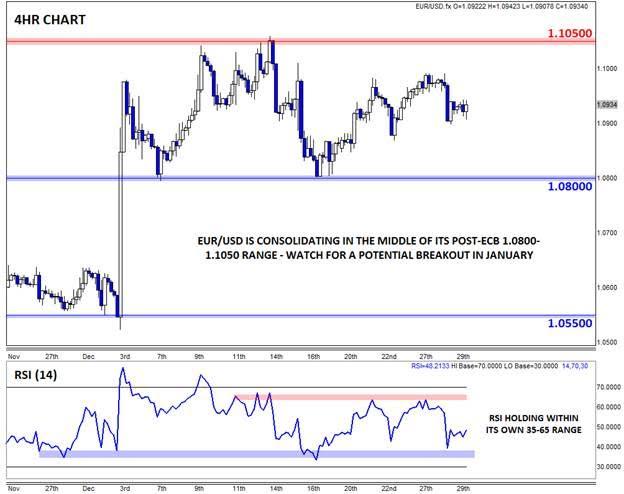![]()
Over the last week or so, we’ve reset the longer-term outlooks for a number of major currency pairs and markets, but now we wanted to take a look at the key short-term levels to watch on the world’s most widely-traded currency pair, EUR/USD.
Of course, there’s been little in the way of meaningful economic data today, but the reports that we have seen still suggest that the Eurozone is struggling to get the economic engine to turn over. Consumer Prices in Spain, the Eurozone’s fourth largest economy, came out flat (0.0%) year-over-year in December, missing expectations of a 0.1% rise. Though this reading did miss economists’ expectations, it’s worth noting that this was still the second-highest reading since June 2014, so ECB policymakers can take solace in the fact that deflationary pressures may be fading.
In a separate report, traders learned that the M3 money supply in the Eurozone rose 5.1% in November, keeping pace with the gains over the last few months. Monetary policy operates with a significant lag, but the increasing quantities of currency in the financial system should eventually lead to an uptick in price pressures in the Eurozone.
Technical view: EUR/USD
On a short-term basis, EUR/USD remains trapped within the 1.0800-1.1050 range that has contained rates since the ECB meeting at the start of this month. As of writing, the pair is moving sideways directly in the middle of the range in the lower-1.0900s and no fireworks are likely this week.
That said, as we flip the calendars to 2016, traders will be closely watching this tight range for a breakout one way or another. A topside breakout (note that the 100- and 200-day moving averages are also looming at 1.1050) could lead to a continuation up toward 1.12 or higher in January, whereas a bearish breakdown could open the door for a retest of support in the 1.05-1.06 zone.
This research is for informational purposes and should not be construed as personal advice. Trading any financial market involves risk. Trading on leverage involves risk of losses greater than deposits.
Recommended Content
Editors’ Picks
EUR/USD clings to gains above 1.0750 after US data

EUR/USD manages to hold in positive territory above 1.0750 despite retreating from the fresh multi-week high it set above 1.0800 earlier in the day. The US Dollar struggles to find demand following the weaker-than-expected NFP data.
GBP/USD declines below 1.2550 following NFP-inspired upsurge

GBP/USD struggles to preserve its bullish momentum and trades below 1.2550 in the American session. Earlier in the day, the disappointing April jobs report from the US triggered a USD selloff and allowed the pair to reach multi-week highs above 1.2600.
Gold struggles to hold above $2,300 despite falling US yields

Gold stays on the back foot below $2,300 in the American session on Friday. The benchmark 10-year US Treasury bond yield stays in negative territory below 4.6% after weak US data but the improving risk mood doesn't allow XAU/USD to gain traction.
Bitcoin Weekly Forecast: Should you buy BTC here? Premium

Bitcoin (BTC) price shows signs of a potential reversal but lacks confirmation, which has divided the investor community into two – those who are buying the dips and those who are expecting a further correction.
Week ahead – BoE and RBA decisions headline a calm week

Bank of England meets on Thursday, unlikely to signal rate cuts. Reserve Bank of Australia could maintain a higher-for-longer stance. Elsewhere, Bank of Japan releases summary of opinions.
